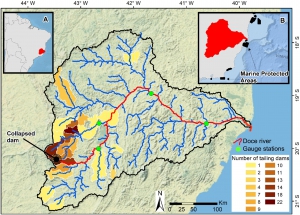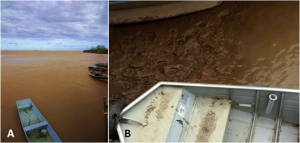Traditional knowledge of Fishers versus an environmental disaster from mining waste in Central Brazil
By Rebecca Varnam, SRC intern
In recent years, the depths of human impacts on the environment have become even more clear (Nyssen, 2004). These impacts are not just specific events that occur in single, isolated locations, but rather multiple events that occur around the world, and in multiple different forms (Phillips, 2001). Here, I am going to focus specifically on a study from Oliviera et al. (2020) on how mining waste released into the Doce River affected artisanal fisheries, following the collapse of a dam associated with the Samarco Mineração (SA) mining company (Figure 1). Assessed are the three different regions in Central Brazil; Conceição da Barra (CB), Regência (RG), and Barro do Riacho (BR).

Map of Doce River, including the Southeastern Brazil dam setup and the collapsed dam location that caused the release of mining waste closest to the three regions assessed in this paper: CB, RG, and BR (Magris, 2019).
Scientists spent about four months performing assessments and interviews in the three central Brazilian regions mentioned above. The procedure began with habitat assessments in each location based on observation and research on the areas before, during, and after the disaster. They completed 120 interviews-to avoid bias, these were performed individually and using a standard questionnaire (Oliviera et al., 2020). The information was then gathered and organized to allow scientists to make conclusions on the impacts this disaster had within this area.
Overall, most fishers mentioned the following, “1) fishing was suspended, 2) the catch was contaminated and its volume decreased and 3) there was degradation in the Doce River basin as far as the river mouth” (Oliviera et al., 2020, p. 4) (Figure 2). These three impacts play a role in not just the environmental health of these designated regions, but also success in the fishing market.

Doce River after the dam collapse in Central Brazil, (B) “Toxic Mud” that accumulated in Doce River (Oliviera et al., 2020).
You may wonder why it was important for these scientists to perform this study. First, there are about 40 million people worldwide that have livelihoods that rely on marine fisheries (FAO, 2018). With this many people relying on fisheries, it is important that changes to this industry are available to not only help the environment but also to protect these families from economic deficits. Second, mining companies establishing in a region can increase aquatic environmental concerns such as increased pollution, contamination, and changing landscapes and ecosystems, which can also affect fisheries within the region (Kossoff et al., 2014). With these environmental concerns and impacts on fisheries, there is an increased need for more research to find the most sustainable and safe methods for mining and dam usage.
In conclusion, this environmental disaster, recognized by most to be the fault of SA mining company, has affected fishers in CB, RG, and BR regions to reduce their fishing practices to only supply for their families as they do not have the money to access other food sources. Fishers are also struggling, as a majority do not have the education to access other job opportunities. Further assessments on the continued impact of this disaster is necessary along with more employment opportunities provided by the SA mining company for those struggling to provide for their families (Olivier et al., 2020).
Works cited
Kossoff, D., Dubbin, W. E., Alfredsson, M., Edwards, S. J., Macklin, M. G., & Hudson-Edwards, K. A. (2014). Mine tailings dams: Characteristics, failure, environmental impacts, and remediation. Applied Geochemistry, 51, 229-245. doi:https://doi.org/10.1016/j.apgeochem.2014.09.010
FAO, The State of World Fisheries and Aquaculture 2018 – Meeting the Sustainable Development Goals, Food and Agriculture Organization of the United Nations, Rome, Italy, 2018.
Nyssen, J., Poesen, J., Moeyersons, J., Deckers, J., Haile, M., & Lang, A. (2004). Human impact on the environment in the Ethiopian and Eritrean highlands—a state of the art. Earth-Science Reviews, 64(3), 273-320. doi:https://doi.org/10.1016/S0012-8252(03)00078-3
Oliveira, P. D. C., Di Beneditto, A. P. M., Quaresma, V. d. S., Bastos, A. C., & Zappes, C. A. (2020). Traditional knowledge of Fishers versus an environmental disaster from mining waste in Central Brazil. Marine Policy, 120, 104129. doi:https://doi.org/10.1016/j.marpol.2020.104129
Magris, R. A., Marta-Almeida, M., Monteiro, J. A. F., & Ban, N. C. (2019). A modelling approach to assess the impact of land mining on marine biodiversity: Assessment in coastal catchments experiencing catastrophic events (SW Brazil). Science of The Total Environment, 659, 828-840. doi:https://doi.org/10.1016/j.scitotenv.2018.12.238
Phillips, J. D. (2001). HUMAN IMPACTS ON THE ENVIRONMENT: UNPREDICTABILITY AND THE PRIMACY OF PLACE. Physical Geography, 22(4), 321-332. doi:10.1080/02723646.2001.10642746
